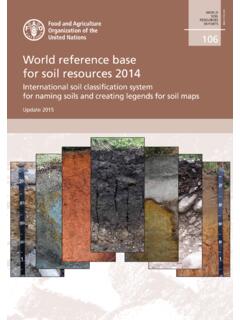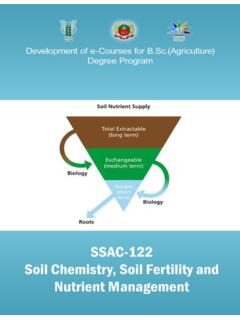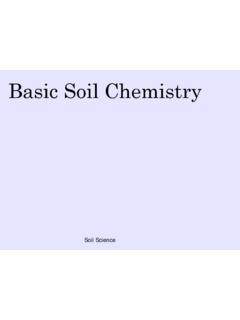Transcription of Soil Test Interpretation - Waypoint Analytical
1 Agronomy Facts 8 Revised: Nov 30, 2017 Soil Test Interpretation Terms and Definitions By Dr. Richard Large Revised by: Dr. Oscar F. Ruiz Jr. _____ _____ REPORT TERMS ppm (lbs/acre) Results may be listed in ppm (parts per million) or pounds per acre. To convert from ppm to pounds multiply by 2 and to convert from pounds per acre to ppm divide by 2. DECISIEMENS/METER (dS/m) Electrical conductivity measurements are often used to measure the amount of soluble salts in the soil. The conductivity increases with increasing soluble salts, and the soil is considered saline when the conductivity reading reaches 2 to 3 dS/m. (1 dS/m = 1 millimhos/cm) RATINGS Most soil test readings on the report are given a rating of very low, low, medium, optimum, or very high.
2 The rating bars are color coded to the rating scale across the top. The purpose of these ratings is to provide a general guideline for determining the optimum nutrient levels. However, the actual value that is best depends on many factors such as crop, yield potential, and soil type. Rating Probability of crop response Very low Close to 100% Low About 75% Medium 50% Optimum/High 0-25% Very High 0-10% Monitor very high levels for excessive nutrient levels that may impede uptake of other nutrients. SOIL ANALYSIS TERMS AND APPLICATIONS SOIL pH The soil pH measures active soil acidity or alkalinity.
3 A pH of is neutral. Values lower than are acid; values higher are alkaline. Usually the most desirable pH range for mineral soils is to and for organic soils to The soil pH is the value that should be maintained in the pH range most desirable for the crop to be grown. Agronomy Facts 8 _____ _____ BUFFER pH This is an index value used for determining the amount of lime to apply on acid soils to bring the pH to the desired pH for the crop to be grown.
4 The lower the buffer pH reading, the higher the lime requirement. PHOSPHORUS The phosphorus test measures that phosphorus that should be available to the plant. The optimum level will vary with crop, yield and soil conditions, but for most field crops a medium to optimum rating is adequate. The Mehlich 3 extraction is useful for a wide range of alkaline to acid soil pHs. Soil Bray P1 is an older extraction used on acid soils. Olsen sodium bicarbonate extraction is another older extraction for P traditionally used on alkaline soils with pHs above but has been used reliably down to pHs of Excessive P levels caused by over application can decrease micronutrient availability of Zn, Mn, Fe, or Cu.
5 POTASSIUM This test measures available potassium. The optimum level will vary with crop, yield, soil type, soil physical condition, and other soil related factors. Generally higher levels of potassium are needed on soils high in clay and organic matter versus soils, which are sandy and low in organic matter. Higher clay content and/or organic matter increases the cation exchange capacity (CEC) of the soil. Sandy soils typically have low CECs therefore potassium can be lost through leaching in sandy, low CEC soils. It is recommended to split applications on low CEC soils to reduce loss. On finer textured soils, potassium loss can occur through fixation.
6 For Mehlich 3 extractions, optimum levels are generally the following: CEC : 95 to 115 ppm CEC : 130 to 155 ppm CEC : 155 to 190 ppm CEC 15+: 175 to 215 ppm CALCIUM Primarily soil type, drainage, liming and cropping practices affect the levels of calcium found in the soil. Calcium is closely related to soil pH. Calcium deficiencies are rare when soil pH is adequate. The level for calcium will vary with soil type, but optimum ranges are normally in the 65% to 75% cation saturation range. Calcium saturations above 85% may indicate a calcareous or gypsiferous soil MAGNESIUM The same factors, which affect calcium levels in the soil, also influence magnesium levels except magnesium deficiencies are more common.
7 Adequate magnesium levels range from 30 to 70 ppm (60 to 140 lbs/ac). The cation saturation for magnesium should be 10 to 15%. Magnesium saturations above 20% can adversely Agronomy Facts 8 _____ _____ affect soil structure, water-infiltration, soil drainage and aerification. SULFUR The soil test measures sulfate-sulfur. This is a readily available form preferred by most plants. Soil test levels should be maintained in the optimum range. It s important that other soil factors, including organic matter content, soil texture and drainage be taken into consideration when interpreting sulfur soil test and predicting crop response.
8 Soil tests resulting in low sulfur levels should be addressed with sulfate fertilizer applications. Elemental sulfur does not provide readily available sulfur. BORON The readily soluble boron is extracted from the soil. Boron will most likely be deficient in sandy soils, low in organic matter with adequate rainfall. Soil pH, organic matter level and texture should be considered in interpreting the boron test, as well as the crop to be grown. COPPER Copper is most likely to be deficient on either low organic matter sandy soils, or highly organic/muck soils. The crop to be grown, soil texture, and organic matter should be considered when interpreting copper tests.
9 A rating of medium to optimum should be maintained. IRON Soil pH is a very important factor in interpreting iron tests. In addition, crops vary a great deal in sensitivity to iron deficiency. Normally a medium level would be adequate for most soils. If iron is needed it would be best applied foliar. When applying to high pH soils, it should be applied only as a chelated form. MANGANESE Soil pH is especially important in interpreting manganese test levels. In addition, soil organic matter, crop and yield levels must be considered. Manganese will work best if applied foliar or banded in the soil.
10 Chelated forms are utilized on high pH soils. ZINC Other factors, which should be considered in interpreting the zinc test, include available phosphorus, pH, and crop and yield level. For crops that have a good response to zinc, the soil test level should be optimum and should be administered in the same fashion as manganese and iron. SODIUM Sodium is not an essential plant nutrient but is usually considered in light of its effect on the physical condition of the soil. Soils high in exchangeable sodium may cause adverse physical and chemical conditions to develop in the soil.



